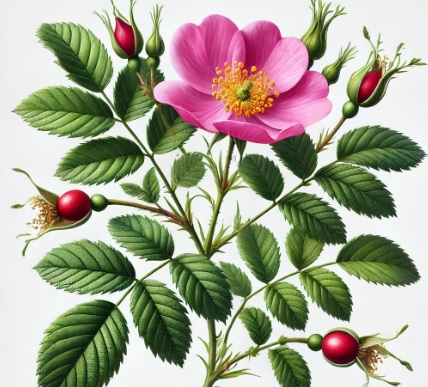Kamchatka rose (Rosa kamchatica) is a species of rose native to the northeastern regions of Asia, including the Kamchatka Peninsula in Russia and parts of the Japanese archipelago. This hardy rose is valued for its resilience in cold climates and its attractive, bright pink flowers. The Kamchatka rose is known for its ability to thrive in challenging environments, making it a popular choice for gardens in colder regions.
Botanical Classification:
Kingdom: Plantae
Order: Rosales
Family: Rosaceae
Genus: Rosa
Species: Rosa kamchatica
Plant Characteristics:
Rosa kamchatica is characterized by:
Bright pink, medium-sized flowers with a simple yet elegant appearance
Glossy, dark green foliage that contrasts well with the vibrant flower color
A compact, bushy growth habit, typically reaching heights of 1 to 1.5 meters and a similar spread
High adaptability to cold climates and various soil types, making it suitable for northern gardens
Chemical Composition and Structure:
The chemical composition of Rosa kamchatica includes:
Essential oils with aromatic compounds such as citronellol, geraniol, and eugenol, contributing to a subtle fragrance
Flavonoids and tannins in the petals and leaves, which offer antioxidant and astringent properties
Anthocyanins responsible for the bright pink coloration of the flowers, also providing additional antioxidant benefits
Uses and Benefits:
Aesthetic: Highly valued for its bright pink flowers and resilient growth, making it an attractive choice for gardens in colder regions.
Cosmetic: Extracts can be used in skincare products and perfumes for their hydrating and aromatic properties.
Medicinal: Traditionally used in herbal remedies for its soothing and astringent effects, though scientific research on its medicinal properties is limited.
Culinary: Petals can be used in infusions and to flavor culinary dishes, offering a delicate floral note.
Applications:
Gardening: Ideal for northern and temperate gardens, used as an ornamental shrub that adds color and beauty to garden beds and borders.
Cosmetics: Extracts incorporated into creams, lotions, and perfumes for their beneficial properties and subtle fragrance.
Culinary: Fresh or dried petals used in infusions and as a flavoring agent in various dishes.
Environmental and Safety Considerations:
Environmental Impact: Non-invasive and well-adapted to cold climates; contributes to garden biodiversity and supports local pollinators.
Safety: Generally safe to handle; however, as with all plants, caution should be taken to avoid potential allergic reactions in sensitive individuals.
INCI:
Hair conditioning agent. A significant number of ingredients with specific and targeted purposes may co-exist in hair shampoo formulations: cleansers, conditioners, thickeners, matting agents, sequestering agents, fragrances, preservatives, special additives. However, the indispensable ingredients are the cleansers and conditioners as they are necessary and sufficient for hair cleansing and manageability. The others act as commercial and non-essential auxiliaries such as: appearance, fragrance, colouring, etc. Hair conditioning agents have the task of increasing shine, manageability and volume, and reducing static electricity, especially after treatments such as colouring, ironing, waving, drying and brushing. They are, in practice, dispersants that may contain cationic surfactants, thickeners, emollients, polymers. The typology of hair conditioning agents includes: intensive conditioners, instant conditioners, thickening conditioners, drying conditioners. They can perform their task generally accompanied by other different ingredients.
Humectant. Hygroscopic compound used to minimise water loss in the skin and to prevent it from drying out by facilitating faster and greater absorption of water into the stratum corneum of the epidermis. The epidermis is the most superficial of the three layers that make up human skin (epidermis, dermis and hypodermis) and is the layer that maintains hydration in all three layers. In turn, the epidermis is composed of five layers: horny, the most superficial, granular, spinous, shiny, and basal. Humectants have the ability to retain the water they attract from the air in the stratum corneum and have the function of moisturising the skin. They are best used before emollients, which are oil-based.
Skin conditioning agent. It is the mainstay of topical skin treatment as it has the function of restoring, increasing or improving skin tolerance to external factors, including melanocyte tolerance. The most important function of the conditioning agent is to prevent skin dehydration, but the subject is rather complex and involves emollients and humectants that can be added in the formulation.
Synonyms:
CAS:
![]() Kamchatka rose
Kamchatka rose 

